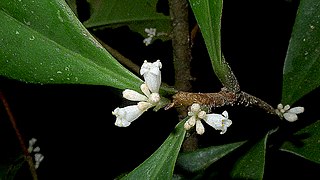
Xylosma is a genus of flowering plants in the family Salicaceae. It contains around 100 species of evergreen shrubs and trees commonly known as brushhollies, xylosmas, or, more ambiguously, "logwoods". The generic name is derived from the Greek words ξύλον (xylon), meaning "wood," and ὀσμή (osmé), meaning "smell," referring to the fragrant wood of some of the species. The Takhtajan system places it in the family Flacourtiaceae, which is considered defunct by the Angiosperm Phylogeny Group.

Sideroxylon is a genus of trees in the family Sapotaceae described as a genus by Linnaeus in 1753. They are collectively known as bully trees. The generic name is derived from the Greek words σιδηρος (sideros), meaning "iron", and ξύλον (xylon), meaning "wood."

Archibaccharis is a genus of flowering plants in the family Asteraceae.

Rogiera is a genus of flowering plants in the family Rubiaceae. It has 15 species and its native range is from Mexico to Colombia.
Appunia is a genus of flowering plants in the family Rubiaceae. It was described by Joseph Dalton Hooker in 1873. The genus is found from southern Mexico, Central America, and northern South America.

Guettardeae is a tribe of flowering plants in the family Rubiaceae and contains about 748 species in 14 genera. Its representatives are widespread geographically and are found in the tropics and subtropics.

Chomelia is a genus of flowering plants in the family Rubiaceae. It is native to Mexico, Central America, the West Indies, and much of South America as far south as Argentina.

Deppea is a genus of flowering plants in the family Rubiaceae. The genus is found in Mexico, Central America and from Brazil to northeastern Argentina.

Daphnopsis is a plant genus in the family Thymelaeaceae. There are 50 to 65 species distributed in the Neotropics. They are shrubs and small trees with tubular or bell-shaped flowers. Individuals are dioecious, with male and female flowers produced on separate trees.

Coussarea is a genus of flowering plants in the family Rubiaceae. The genus is found from southern Mexico to tropical America.

Lisianthius is a genus of flowering plants belonging to the family Gentianaceae.










